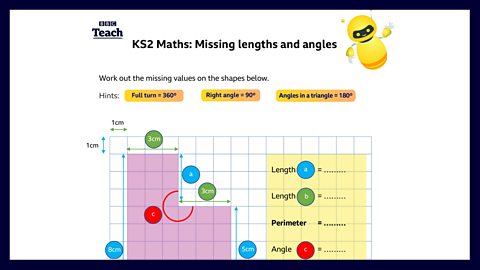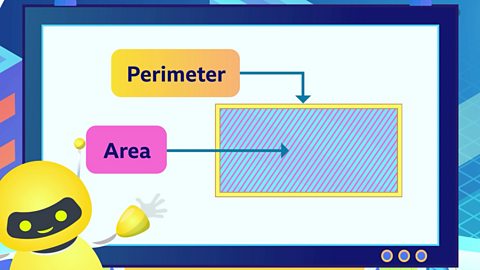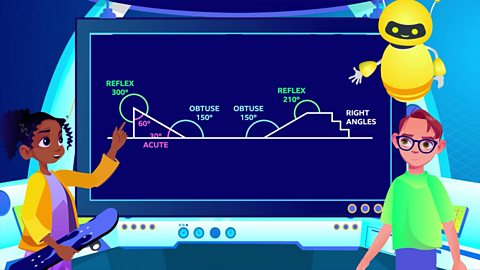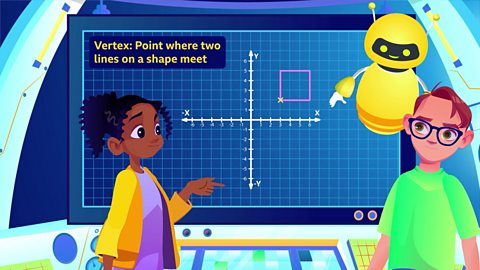[ALARM BLARES]ZACH: Uh-oh, I think thereβs something wrong with our virtual city, Kayla.
KAYLA: Oh man, that does not look good!
ADA: Virus detected! Virus detected!Press my emergency button for instructions.A virus has corrupted the software of Neon City.Zach and Kayla, you must find the missing lengths and angles in the next three minutes, or the city will be erased.
KAYLA: Oh no!Come on then, give us the first question.
ADA: You must calculate the perimeter of this rectilinear shape.
ZACH: Yeesh! Iβm not a fan of working under pressure.Okay, letβs think.What are the missing lengths?Side A must be 3 + 6 = 9 centimetres.
KAYLA: And to work out B, we need to subtract 7 from 10, which equals 3 centimetres.
ZACH: Now, we just need to add up all the lengths to find the perimeter.9 + 10 + 3 + 3 + 6 + 7 = 38!
ADA: Correct.You must solve three more problems to save the virtual city.Next question.Calculate angles βaβ and βbβ.
KAYLA: Okay, well, βbβ is a right angle so βbβ is 90 degrees.
ADA: Correct.
ZACH: And how about βaβ?Hmmβ¦The bit missing from βaβ is a right angle too; 90 degrees.And how many degrees in a full turn again?
KAYLA: 360!
ZACH: Ah, so if we subtract 90 from 360, we will get the missing angle.360 β 90 = 270 degrees.
ADA: Correct.Find the missing angle in this triangle.Remember, all of the angles in a triangle always add up to 180 degrees.
ZACH: Oh dear! I donβt have my protractor.
KAYLA: Itβs okay, weβve got this!So, that angle is 56 and that angle is a right angle, 90 degrees.We need to add them together.90 + 56 = 146.
ZACH: All the angles add up to 180 degrees altogether because itβs a triangle.So, 180 minus 146 will tell us the missing angle.34 degrees.
ADA: You are correct.Now, for your final challenge.If the perimeter of this shape is 14 metres, what is the missing length?
KAYLA: Ah, remember, those little lines mean that those two sides are the same.
ZACH: Oh yes, it must be an isosceles triangle because it has two equal sides.That other side is also 6 metres then, and we know the perimeter is 14.How do we get that missing side?
KAYLA: We need to add up these two.6 + 6 = 12.And then do 14 minus 12.The missing side measures 2 metres.
ADA: You are correct.City virus immobilized.
ZACH: Phew! I thought our city was a goner.
KAYLA: Me too! I need some chill time after that.
ADA: Excuse me, I feel a little peculiar.Where were we with our park design?
BOTH Huh!
A computer virus has corrupted the Neon City software. Zach and Kayla must answer four questions within three minutes, or their city will be erased.
First, the children are challenged to calculate the perimeter of a rectilinear shape on the screen. Zach and Kayla talk through their calculations to find the missing lengths, then add them together to find the perimeter.
Second, they calculate the missing angles from inside a rectilinear shape. Next, they have to work out the angles inside a triangle, using their knowledge that the angles inside a triangle always add up to 180Β°.
Finally, they work out the missing sides of an isosceles triangle. Zach and Kayla solve the problems just in time!
This short animated film is from the ΒιΆΉΤΌΕΔ Teach series, Neon City: Measurement and Geometry.
Download/print an A4 activity sheet for this episode (PDF, 350KB). See link below for answers.

Teacher notes
Before watching
You may want to recap some key vocabulary, such as perimeter, rectilinear, right angle, reflex angle, isosceles triangle.
During the film
Depending on the focus of your lesson, you may want to pause the film at one of the questions and spend the rest of the lesson focusing on the maths skills required to answer this question. Alternatively you may wish to watch the whole episode and focus on the problem solving skills required to tackle any question of this type.
As Zach and Kayla address each question, give your pupils the opportunity to discuss how they would go about solving the problem, and identify that there may be many different ways to solve one problem.
After watching
You could give the children a chance to discuss how they would go about solving each problem. You could give them stem sentences relating to each question, for example:
- The angles inside a triangle always add up to β¦degrees, therefore the missing angle must be β¦degrees.
You could give the children opportunities to solve questions requiring them to find the missing lengths and angles from a variety of shapes.
(PDF, 690KB)
Curriculum notes
This short film is suitable for teaching maths at KS2 in England and Northern Ireland, 2nd Level in Scotland and Progression steps 2 and 3 in Wales.
More from Neon City: Measurement and Geometry
Measuring area. video
Ada introduces Zach and Kayla to the concept of area, and different ways to measure and calculate the area of rectangles, triangles and composite shapes.

Perimeter. video
Zach and Kayla are creating windows for their virtual house design and Ada explains how they can work out the perimeter for the windows they want.

Volume. video
Kayla and Zach decide to build a swimming pool for their virtual city and Ada explains how to calculate the volume and capacity of a cuboid shape.

Metric and imperial measurements. video
Kayla and Zach decide to build a new hovertrain system from the city to the beach, but they get confused between kilometres and miles. Ada explains how to calculate betwen the two measurement systems, metric and imperial.

Measuring angles - Part 1. video
Kayla and Zach are designing ramps for the skatepark and Ada explains that designing ramps requires us to measure angles β the amount of turn between two lines.

Measuring angles - Part 2. video
Whilst adding ramps to their virtual skatepark, Zach and Kayla progress from measuring angles to calculating angles on a straight line and full turn.

Regular and irregular polygons. video
Zachβs design for a pond in the virtual city park leads to Ada explaining the properties of regular and irregular polygons.

Coordinates on a grid. video
Kayla and Zach are designing a fairground and need to plot where to place the different rides, so Ada teaches them about the x-axis and y-axis on a coordinate grid.

Units of time. video
Ada asks Kayla and Zach a series of quiz questions, requiring them to convert from one time measurement unit to another.
